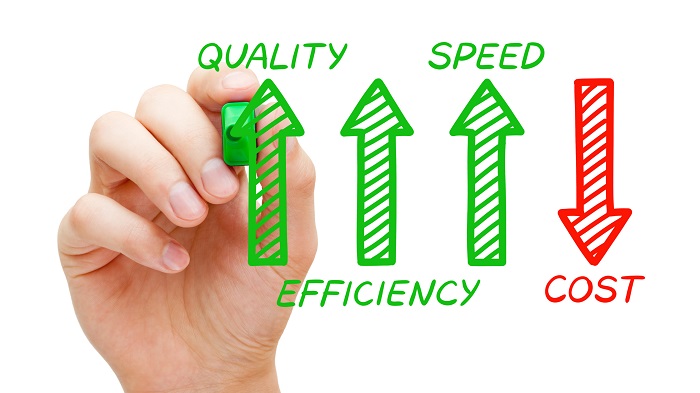 We hear a lot about efforts to improve workflows and the favorable impact these have on efficiency which then leads to cost reductions. At the top level, this should not be a controversial concept because time equals money so, reductions in the time taken to achieve a task will lead to a reduction in cost. However, although this concept should not be controversial, what may be overlooked when evaluating workflows is the resources expended to improve them.
We hear a lot about efforts to improve workflows and the favorable impact these have on efficiency which then leads to cost reductions. At the top level, this should not be a controversial concept because time equals money so, reductions in the time taken to achieve a task will lead to a reduction in cost. However, although this concept should not be controversial, what may be overlooked when evaluating workflows is the resources expended to improve them.
Think, for example, about a complete overhaul of an accounting process from the initial sales order all the way through invoicing and collection of the funds associated with the transaction. Think about this in the concept of a 20 person accounting team and that the proposed workflow change will affect the entire team. Each of the team members must be trained so they fully understand the new process and are able to achieve the new efficiency goals.
So, let's just assume it requires 8 hours of training for each person. This means it is going to take 160 hours at a fully burdened cost of say $60 per hour, meaning the total training cost may be as much as $10,000. Next, let's assume software on a SaaS subscription of $30 per month per user is required in order for the new workflows to be implemented. This means there's a recurring cost of $600 per month or $7,200 per year. Over 5 years the total cost to implement the required changes will be $46,000 which constitutes a significant investment.
Now let's assume that the efficiency improvement saves each member of the team on average one hour per week. With 20 team members benefiting, that's 20 hours per week or 5,200 hours over a five year period. 5,200 hours multiplied by $60 per hour equates to $312,000 in savings. Remember, our cost to achieve these savings was $46,000 so, over a five-year time frame there will be a substantial (nearly 800%) return on the initial amount invested.
The point here is that improvements in efficiency usually don't come about without some upfront or recurring expense and that these expenses must be taken into account when deciding whether to move forward with a change.
What else stands in the way of implementing change?
Unfortunately, there are often intangible "human" factors that come into play when considering changes because, for a number of reasons, workers often resist change.
1. They are usually well-practiced in existing workflows which are probably quite simple to execute because they have been in place for a long time. The potential for disrupting this familiarity introduces resistance.
2. As we've already highlighted, improvements in efficiency result in reductions in cost. Improving human efficiency means less labor is required to carry out a set of pre-defined tasks, and less labor translates to fewer jobs. Workers resist change because they may be fearful of their job security.
When implementing change, there may be discreet and subtle, even sub-conscious, efforts to sabotage the changes management are seeking because the workers want to maintain the old way of doing things.
In keeping things as they are, not only do things stay within the workers' comfort zone, but they may also (from the workers' narrow perspective) help maintain an illusion of job security.
What we may conclude at this point in our narrative is that the most desirable changes to work practice will be those that have the lowest upfront cost to implement, and those that are most likely to be embraced without resistance by workers.
Copier Machines and Efficiency
While copier machines and efficiency may be considered by many as unlikely companions, let us consider our narrative in the context of how we typically call for service and repair, or how we typically reorder consumables for a device such as a copier machine. Copier machines are, historically, a constant source of frustration because they are notoriously unreliable and, when they break down, they negatively impact project deadlines.
1. Although copier machines are typically labeled with the number to call for service, no one knows for sure if it's a current sticker and whether the service contract is still valid.
2. Then there's the question of who is going to take responsibility for placing a service call. The first person to notice the issue may just shrug their shoulders and walk away thinking their print job can wait and it's not worth the hassle of figuring out who they should be calling.
3. The copier problem is often ignored until, finally, a critical print job comes along that demands attention before it can be completed. However, by this stage a more serious implication has developed from the negligence to report the problem when it was first detected.
Copiers and Asset Monitoring Technology
There are two technology components available which are designed to eliminate the frustration resulting from failing to call-in a service problem on a printing device that may be broken, or out of operation for another reason such as lack of ink or toner.
1. A Data Collection Agent (DCA) that constantly monitors the health of the device as well as the status of the ink or toner cartridges it consumes.
2. A unique QR code attached to the device that can be scanned by anyone in the office in order to report a problem.
The three key points here are:
1. Introducing the ability to monitor a device 24/7 and to run the data collected against a master database that knows at when different components on the device may fail. Intelligent use of this data enables preventive maintenance to be carried out thereby minimizing the risk of equipment breakdown and the subsequent disruption from occurring.
2. Monitoring ink or toner levels 24/7 and using the consumption data (pages printed and percentage of ink or toner page coverage), to predict when the cartridge needs to be replaced, practically eliminates the risk of ink or toner depletion as a reason for downtime. Previously, without this technology, someone had to physically process an order for ink and toner and set in motion all the hidden costs associated with a vendor PO, future invoice, and subsequent payment of that vendor invoice. Even worse, many times in order to reduce the risk of an outage, additional ink and toner supplies may have been kept on the premises, tying up cash and risking obsolescence.
3. Eliminating the frustration involved when an unexpected problem does occur, simultaneously removing break points in the current workflow, and solving the reluctance of employee to take responsibility for reporting the problem when it is first detected, are all taken care of by simply scanning the QR code. No more hunting around to find who the service company is because anybody can scan the code from any mobile device, enter a reason, add a photo if needed, and click to send.
In this new environment, put yourself in the shoes of an employee staring in frustration at the copier machine that has broken down once again. Instead of a heavy sigh and turning away, scan the QR code below, install the 2clixz app, and see for yourself how easy it is to create a ticket to summon the repair guy.
 Implementing these process improvements meets the required adoption criteria we have outlined above.
Implementing these process improvements meets the required adoption criteria we have outlined above.
1. There is no cost incurred by the adopting company.
2. There is unlikely to be any employee resistance because the technology eliminates a recurring frustration almost everyone has experienced from copier breakdowns while posing no threat to job security.
3. The technology adds value at the customer (user) level.
Various estimates over the years have put ink and toner at around 30-35% of the total spend on office products by a company. If a customer is spending $5,000 a year on ink and toner then it's probably spending close to $15,000 per year on all its office products and supplies. This becomes a significant expense to budget and to maintain control of, especially as employees have been forced to disperse and work out of remote locations due to the COVID-19 pandemic.
By combining the business intelligence gathered from the monitoring software along with the mobile app capabilities, not only does it become possible to electronically submit service and repair requests, it also becomes possible to manage the total spend via the budget control features embedded in the app software.
There is no reason to stop at the copier machine
Think of all the other assets typically used in the office and general work environment. All the way from delivery vans, HVAC equipment, warehouse equipment, break room equipment such as water coolers, coffee machines, snack vending machines, etc. Each physical asset can be tagged with a QR code that is linked to the respective service providers along with other pertinent information such as expiry dates on extended warranties, etc. The list is endless and the time saving for submitting repair or replenishment requests, when compared to conventional methods, adds up to become increasingly significant.
Conclusions:
By adopting technology it becomes possible to reduce the cost of ownership on almost every physical asset used in a typical business environment. The cost of ownership may be reduced by improving the efficiency associated with mundane matters like placing service calls, eliminating downtime associated with supplies running out, and conducting routine and preventative maintenance according to the manufacturers recommended schedule in order to extend the useful life of the equipment.
To learn more about the technology enhancements designed to help improve efficiency in the office and to reduce the cost of ownership on a myriad of day-to-day items, please click the button below to access our white paper.